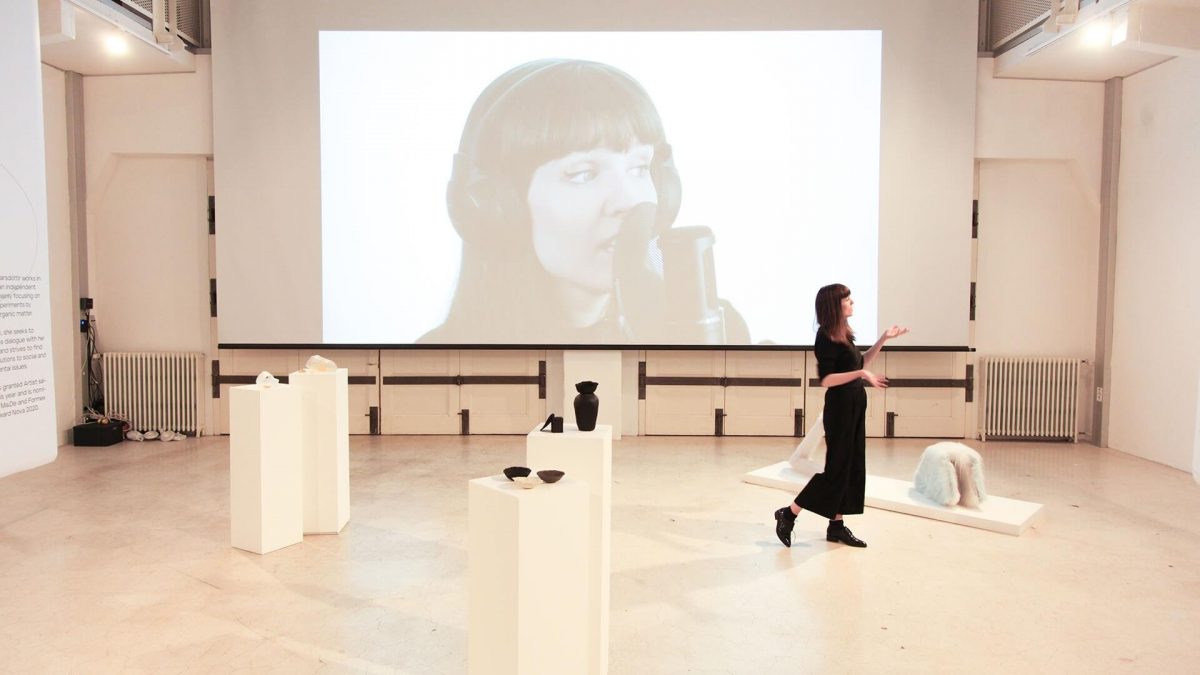REYKJAVÍK – ‘How can we push the limits of exhibitions and open up new realms of experiences?’ designer Valdís Steinarsdóttir asks. For Steinarsdóttir, the answer has been Autonomous Sensory Meridian Response (or, as the Internet knows it best by, ASMR). Currently on show at the Reykjavík Art Museum for DesignMarch 2020, ASMR U Ready? gives viewers a tactile, material experience despite the touchless times we’re living in. The Icelandic designer, who has been exploring solutions to replace toxic materials with natural ones, instead turned to the senses of sight and sound to engage exhibition visitors.
ASMR U Ready? showcases some of Steinarsdóttir’s recent projects – Bioplastic Skin, HorseHair and Just Bones – through the medium of film. A clear shot and sensitive microphone allow viewers to feel as if they are touching the materials themselves, with all of the sensations that come along. ASMR is a relatively young phenomenon-trend – the term was only coined in 2010, by a woman who wanted to put a name to the ‘peculiar sensation’ she sometimes, inexplicably felt doing random actions. The practice of recording these actions – everything from baking to writing to cleaning – to illicit those calming ‘tingles’ has blown up on YouTube and other video platforms since. The videos emphasize, and give people the chance to relish in, the sensory experience of simply being.
Steinarsdóttir saw the potential that ASMR had to unlock a different side of exhibition-going – one that’s especially relevant now considering COVID-19 has bereft us of our ability to use our senses at full capacity. As part of a collaboration between Frame and DesignMarch, we spoke with the designer about her work.

Touching has become a kind of a taboo and an enormous change for some of us, but it’s also a compelling challenge
How has COVID-19 affected your work as a designer? Tactility seems to be an important property in your portfolio.
I think we designers have an inherent quality for responding to changes in real time, particularly to drastic environmental changes. If my exhibition wouldn’t have been delayed because of COVID-19 and held in March, as it originally was planned, it would have been a totally different exhibition and experience.
My work has mainly revolved around material experiments, and I have noticed that when people touch the materials, they understand them much better. After COVID-19, I began to view the world differently, like everybody. We now live in another reality. Touching has become a kind of a taboo and an enormous change for some of us, but it’s also a compelling challenge — how do I let the exhibitors experience the materials without touch? That is why I decided to use ASMR in my exhibition this year – to cater to a changed worldview when showcasing my work.
Can you explain how you use ASMR in the exhibition and walk us through the visitor experience?
I will be showcasing a series of material experiments where I researched the meat industry and the various biological waste materials it produces. With these materials I want to reflect on society’s meat consumption and examine the waste that follows.
In the exhibition, visitors will be able to hear sounds of materials that they would normally not pay any attention to if they had the opportunity to feel it. The tactile feel would most likely overwrite all other senses. Instead I want to focus all the cognitive processing power on the audible and visual aspects of these very physical objects using ASMR audio and video recordings. One of the core ideas of ASMR is the sensation of intimacy and closeness which I’m hoping the audience will experience as well. I will also be talking about my materials and explaining them using the help of ASMR so in a sense people can in a way experience me in the exhibition.

Do you think ASMR will continue to play a role in our physical environments post-pandemic as well? Why, and in what way?
We as a society have been rethinking our relationship with one another. In my experience, although digital communication has been helped a great deal during quarantine, there is still a human element missing. I find that ASMR has the ability to bring that human element of intimacy which I have not experienced in the digital world until now. Maybe, in the near future, we can have an ASMR option in video calls.
ASMR has the ability to bring that human element of intimacy which I have not experienced in the digital world until now
Are there other typologies you see fit for the addition of ASMR-inspired layers, like retail for example? And are there any other ‘digital hypes’ that you can envision will translate to our physical worlds?
Now that we have to rethink the way we interact with our surroundings, there are a lot of new areas we haven’t explored yet. I like the idea of transposing stimuli between senses using technology, like a digital synesthesia. Perhaps we could listen to products instead of touching them.
We have to be open for the changes that the digital world has to offer to our physical world. But, at the same time, be extremely critical of it and not become too dependent on it.

